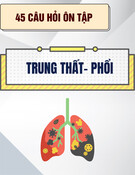
T
ẠP CHÍ KHOA HỌC
TRƯ
ỜNG ĐẠI HỌC SƯ PHẠM TP HỒ CHÍ MINH
Tập 21, Số 9 (2024): 1682-1691
HO CHI MINH CITY UNIVERSITY OF EDUCATION
JOURNAL OF SCIENCE
Vol. 21, No. 9 (2024): 1682-1691
ISSN:
2734-9918
Websit
e: https://journal.hcmue.edu.vn https://doi.org/10.54607/hcmue.js.21.9.4241(2024)
1682
Research Article1
SYNTHESIS OF NEW COUMARIN DERIVATIVES
AND EVALUATION OF THEIR ANTI-CANCER ACTIVITY
Le Tin Thanh1*, Doan Minh Hieu2, Nguyen Thi Thu Trang1,
Le Thi Thanh Huong3,4, Vu Thien Y2, Nguyen Phu Hung3,4, Duc Duy Vo5
1Ho Chi Minh City University of Education, Vietnam
2Faculty of Pharmacy, Ton Duc Thang University, Vietnam
3Faculty of Biotechnology, TNU-University of Sciences, Vietnam
4Center for Interdisciplinary Science and Education -CISE, Thai Nguyen University, Vietnam
5School of Applied Chemistry, Tra Vinh University, Vietnam
*Corresponding author: Le Tin Thanh – Email: thanhlt@hcmue.edu.vn; ducduy.vo@gmail.com
Received: April 19, 2024; Revised: June 04, 2024; Accepted: June 08, 2024
ABSTRACT
A fragment-based approach has been applied to derive 2-(7-hydroxy-2-oxo-2H-chromen-4-
yl)acetic acid 1 into 4 new coumarin derivatives 2a-d through amide bonds. The compounds were
screened for their anticancer activity using MTT assay on MCF-7 and HepG2 cell lines. The results
showed that compounds 2a-c significantly inhibited MCF-7 cells at 40 µM (29-38%) while
compound 2d is a strong HepG2 inhibitor with IC50 of 21 µM. Docking studies of the most potent
compound 2d suggest its HepG2 antiproliferative activity could be mediated through multikinase
inhibition of p38α, VEGFR2 and FGFR-1. Further optimisation should lead to a more potent
compound.
Keywords: 2-(7-hydroxy-2-oxo-2H-chromen-4-yl)acetic acid; amide coupling; anticancer;
MCF-7; HepG2; molecular docking
1. Introduction
Fragment-based drug discovery is an established field for discovering new drug
candidates. Over the past 20 years, 40 clinical candidates and four drugs have been
discovered using this strategy (Denis et al., 2021). Typically, fragment with molecular
weight < 250 will be grown and optimised into more extensive drug-like compounds, using
chemical reactions, as drug candidates for clinical studies. On the other hand, coumarin is a
class of compounds present in both natural and synthetic compounds and has a wide range
of biological activities such as anticancer, antibacterial, antiviral, etc. (Rawat & Reddy,
2022). Drugs containing coumarin are known, such as 4-methylumbelliferone (choleretic
Cite this article as: Le Tin Thanh, Doan Minh Hieu, Nguyen Thi Thu Trang, Le Thi Thanh Huong, Vu Thien Y,
Nguyen Phu Hung, & Duc Duy Vo (2024). Synthesis of new coumarin derivatives and evaluation of their anti-
cancer activity. Ho Chi Minh City University of Education Journal of Science, 21(9), 1682-1691.






























